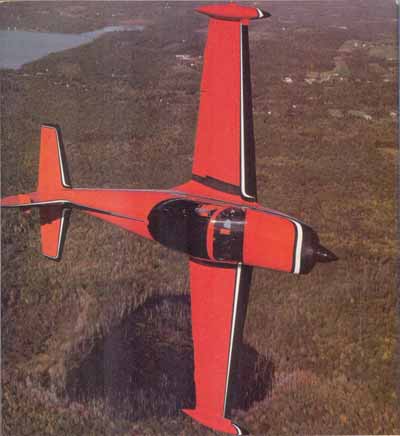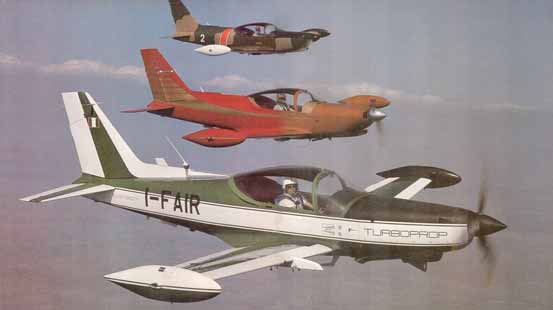PAGE TWO
 |
| The famous Harry Shepard in his straight SF260,
one of the original aircraft imported and marketed as WACO Meteors. |
During the 1970s, several private owners imported various used
SF.260s from Europe and eventually the factory flew two early C models
over to see if the American market would buy their airplane. Apparently
they weren't met with hordes of anxious buyers at their first landing,
so they went home.
The frustrations of SF.260 owners and would-be owners have centered
around both the reluctance of the factory to sell the airplane along
with the lack of an American support system . . . if you wanted parts,
you waited a long time or went over to get them yourself. Recently,
however, Siai-Marchetti sought to remedy that situation by working
with a Fort Worth, Texas, based company, Fox Five One, to develop a
center for SF.260 support. Although not directly allied with the factory,
Fox Five One has imported quite a number of used aircraft as well as
currently having the sales rights for the eight nearly new airplanes
brought over to Oshkosh, celebrating Col. Balbo's around the world
flight. Siai-Marchetti also has a direct representative, Mike Moore
in Miami, Florida, who is their Western Hemisphere sales representative
as well as demonstration pilot. All new and military aircraft, whether
recip or turbine, will come directly through him.
With 800 airplanes in operation in twenty-four countries
of varying states of development and stability, it would seem only
logical that it is only a matter of time before damaged or well-used
SF.260 airframes should begin to show up on the surplus market. According
to Mike Moore, some of the countries interested in the turboprop are
having their "C" models converted. A few other countries
are discussing the possibility of trading in their As and Bs to the
factory. These used aircraft presumably will be pipelined through Fox
Five One. Some of these aircraft are bound to be surplused in the immediate
area of the country of use, or, conceivably, even abandoned
as they become either out-dated or beyond the capabilities of local
repair shops. This raises the exciting possibility of early model SF.260s
derelict in far corners of the world to be bought at bargain basement
prices.
One thing should be pointed out is that the 260 is not a simple airplane.
The SF.260 was designed to be a high-performance airplane and uses
high-performance production techniques and standards. The aircraft
is simply not a bunch of parts bolted together but rather a finely
crafted assemblage of components, all of which must match perfectly
or the resulting aircraft could be a real handful. Anyone expecting
to repair a damaged SF.260 had best approach it as if they are preparing
to reskin a P-51, rather than rebuild a Piper Cherokee.
If I were honest, I would admit to an awful lot of prejudice, because
I happen to like the SF.260. I think, and always have thought, it is
the ultimate airplane for sport pilots needing cross-country performance
and a little ego-stroking. So when I found the turboprop 260 was in
Florida on a demo tour, I promptly got on the phone and arranged a
rendezvous with Mike Moore and the SF.260 TP at Jacksonville for a
quick flight down to River Ranch Airport, the site of one of the more
fun aviation happenings . . . the River Ranch Swift Fly-In.
Unfortunately, between being screwed up by the airlines and trying
to stuff a couple pilot reports and air-to-air missions into too short
a time frame, our schedule allowed us to get the photography done but
only several short hours of flying in the C model and TP. So Mike worked
it out with Paul Sterbutzel of Washington, DC, who was gracious enough
to loan us his airplane for a weekend of tail twisting. John Stirling,
also of the DC area, volunteered to bring the plane and sat patiently
in the left seat, doing his best to conceal his fear and amusement
at my attempts at being a Third World Fighter Pilot.
The airplane Stirling brought to Andover, New Jersey, was one of the
nearly new 260 Cs which participated in the Balbo anniversary
flight to Oshkosh, and it still bore its Oshkosh trappings . . . two-foottall
stickers festooned its every surface, making the sleek design look
more like a rolling billboard than an Italian fighter trainer a long
way from home.
This was the first of the new C models I had a chance to carefully
scrutinize. I had been told many times that the C's refinements eliminated
some of the hairier characteristics associated with the A. It's easy
when looking down the wing to see one of those refinements
. . . the SF.260 C had a very definite cuff at the leading edge towards
the tip. This was supposed to do away with the A model's distressing
habit of losing aileron control at low speeds and dropping a wing when
you least expected it on landing. Also, the C models were equipped
with servo ailerons, which would lighten up the A model's responsive,
but slightly heavy, ailerons.
On saddling up, another immediate difference became apparent . . .
the airplane is set up to be soloed from the right, not the left. Although
dual sticks protrude from the floor, the aircraft has all flight instruments
set in the right instrument panel so the pilot is flying with the stick
in his right hand and all engine and trim controls in his left, just
like a fighter. A dual throttle is also mounted on the left cockpit
wall for the instructor pilot. The entire cockpit has a quasi-military
feel with gray paint and fiberglass seats meant to accept parachutes.
SF.260s are not overly blessed with room, not by Wichita standards
at any rate. Although the cockpits are certainly wider than they need
to be, passengers have been known to complain about having no place
to put their feet, since legs are captured fighter-style under the
instrument panel with the control column sticking up between them.
The back seat is especially tight and is placarded to 250 pounds. Having
spent many hours in the back of 260s, I've found it to be perfectly
comfortable because when the 250-pound limit is observed, the back
seat is limited to one decent-sized male who can sit crosswise or two
125-pound little people who don't need that much room to begin with.
Practically all my experience in SF.260s has been with the fuel-injected,
modified versions of Kingry and Shepard. Once I pulled the canopy shut,
I prepared for the starting ritual we always went through on their
airplanes, which was to make a wild guess as to the best thing to do
and hope it would start. Not so with the carbureted 260 C. You just
crank it like any other airplane and it bursts into life with a little
less harsh exhaust noise than there is associated with the A models.
Once fired up and taxiing, I once again marveled at the visibility
and general feel of the SF.260 on the taxiway. The nosewheel steering
and the brakes work beautifully together.
GO TO NEXT PAGE
|

